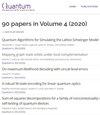自发Floquet态的同时对称破缺:时间Floquet- nambu - goldstone模式,Floquet热力学和时间算符
IF 5.1
2区 物理与天体物理
Q1 PHYSICS, MULTIDISCIPLINARY
引用次数: 0
摘要
我们研究了自发Floquet态的同时对称破缺,重点研究了原子凝聚的具体情况。我们首先通过调用广义吉布斯系综,描述了一个定态的Nambu-Goldstone (NG)模的量子化,同时打破了哈密顿量的几个对称性,从而实现了对问题的热力学描述。量子化过程涉及到一个Berry-Gibbs连接,它依赖于与每一个破缺对称相关的宏观守恒电荷,并且其曲率在广义规范变换下不是不变的。我们将形式主义推广到Floquet态,将Goldstone定理转化为零准能量的Floquet- nambu -Goldstone (FNG)模的出现。在自发Floquet态的情况下,由于连续的时间平移对称破缺而产生了一个真正的时间FNG模式,其量子振幅提供了量子力学中罕见的时间算子的实现。此外,由于它们守恒能量,可以证明自发的Floquet态具有守恒的Floquet电荷。传统的Floquet系统也允许用Floquet焓来描述热力学,即能量对Floquet电荷的勒让德变换,因为它们在固定频率下工作。我们将我们的形式主义应用于自发Floquet状态的特定实现,即CES状态,它打破了$U(1)$和时间平移对称性,代表了一个时间超固体。我们数值计算了它的密度-密度相关性,预测在很长一段时间内由时间FNG模式主导,观察到模拟和理论之间的显著一致性。基于这些结果,我们提出了一种可行的实验方案来观察CES状态的时间FNG模式。本文章由计算机程序翻译,如有差异,请以英文原文为准。
Simultaneous symmetry breaking in spontaneous Floquet states: temporal Floquet-Nambu-Goldstone modes, Floquet thermodynamics, and the time operator
We study simultaneous symmetry breaking in spontaneous Floquet states, focusing on the specific case of an atomic condensate. We first describe the quantization of the Nambu-Goldstone (NG) modes for a stationary state simultaneously breaking several symmetries of the Hamiltonian by invoking the generalized Gibbs ensemble, which enables a thermodynamical description of the problem. The quantization procedure involves a Berry-Gibbs connection, which depends on the macroscopic conserved charges associated to each broken symmetry and whose curvature is not invariant under generalized gauge transformations. We extend the formalism to Floquet states, where Goldstone theorem translates into the emergence of Floquet-Nambu-Goldstone (FNG) modes with zero quasi-energy. In the case of a spontaneous Floquet state, there is a genuine temporal FNG mode arising from the continuous time-translation symmetry breaking, whose quantum amplitude provides a rare realization of a time operator in Quantum Mechanics. Furthermore, since they conserve energy, spontaneous Floquet states can be shown to possess a conserved Floquet charge. Conventional Floquet systems also admit a thermodynamic description in terms of the Floquet enthalpy, the Legendre transform of the energy with respect to the Floquet charge, as these operate at fixed frequency. We apply our formalism to a particular realization of spontaneous Floquet state, the CES state, which breaks $U(1)$ and time-translation symmetries, representing a time supersolid. We numerically compute its density-density correlations, predicted to be dominated by the temporal FNG mode at long times, observing a remarkable agreement between simulation and theory. Based on these results, we propose a feasible experimental scheme to observe the temporal FNG mode of the CES state.
求助全文
通过发布文献求助,成功后即可免费获取论文全文。
去求助
来源期刊

Quantum
Physics and Astronomy-Physics and Astronomy (miscellaneous)
CiteScore
9.20
自引率
10.90%
发文量
241
审稿时长
16 weeks
期刊介绍:
Quantum is an open-access peer-reviewed journal for quantum science and related fields. Quantum is non-profit and community-run: an effort by researchers and for researchers to make science more open and publishing more transparent and efficient.
 求助内容:
求助内容: 应助结果提醒方式:
应助结果提醒方式:


